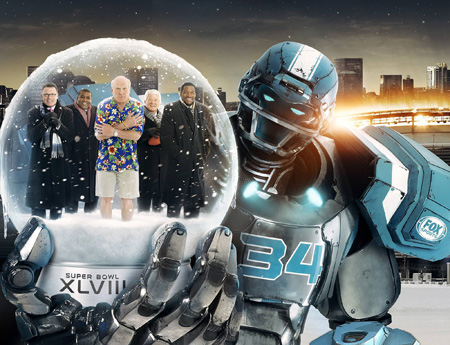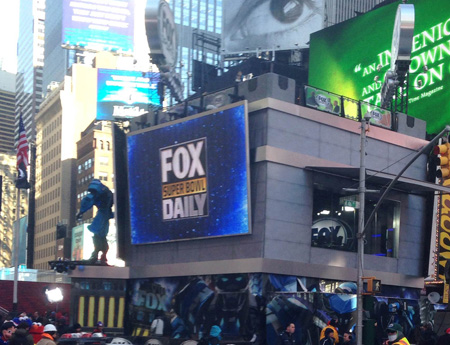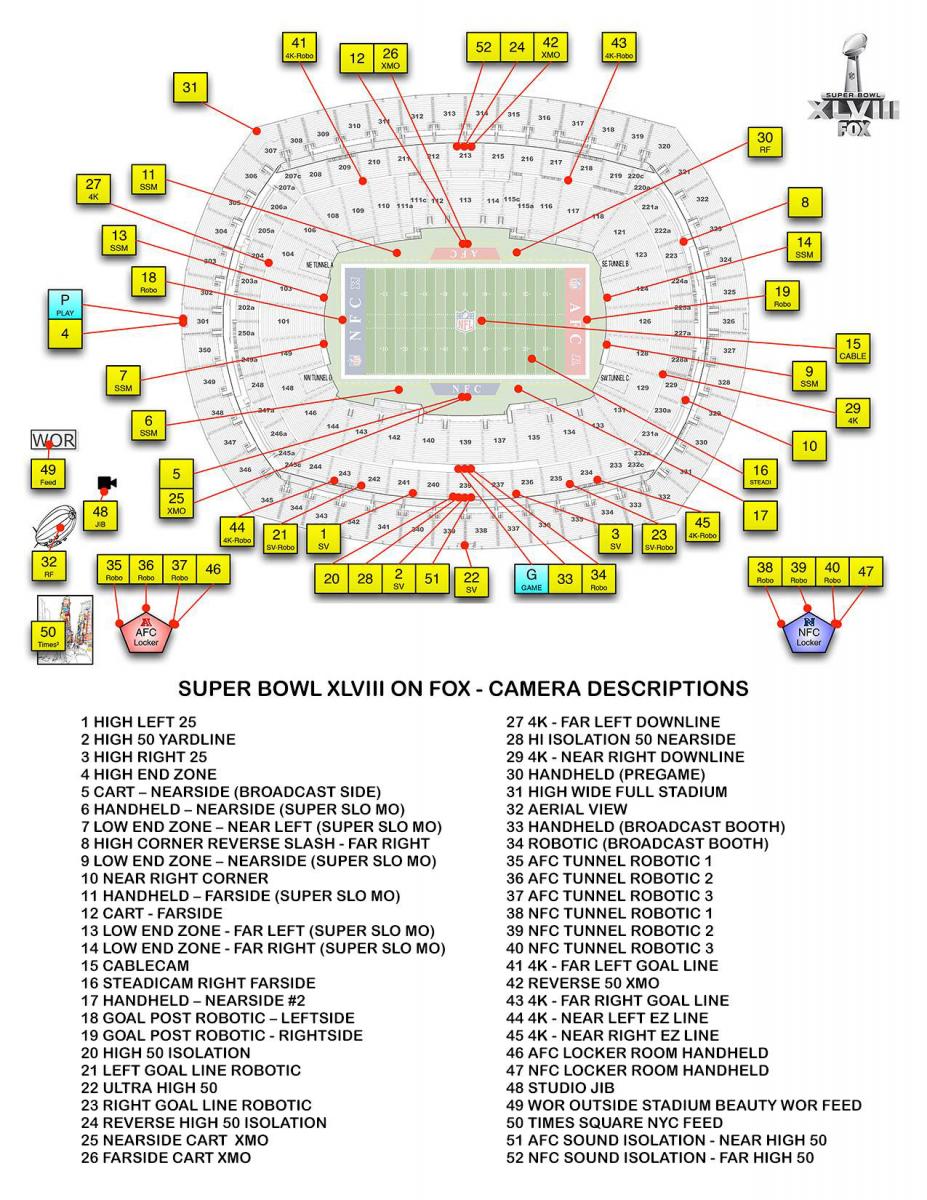The Tech Behind Super Bowl XLVIII

The biggest tech changes for this year's Super Bowl match-up between the Denver Broncos and the Seattle Seahawks on February 2 will be the scale of the production that Fox Sports is putting together, with coverage of various events from multiple venues on a slew of channels.
"Because we are programming for multiple channels, the scope of this thing is huge," explains Jerry Steinberg, senior VP of field operations at Fox Sports. "It is no longer simply preparing for a huge game on Sunday."
The actual game will air on Fox in English and on Fox Deportes in Spanish, a first.
Viewers can also watch a live stream on FoxSportsGo.com and the Fox Sports Go iPad app in both languages.
But there will also be coverage of venues in New York City and New Jersey and a variety of Super Bowl themed programming, which started on January 26 on Fox, Fox Sports 1, some FOX Sports Regional Networks, Fox Deportes, Fox News Channel, Fox Business Network, FX, FXX, FXM, National Geographic Channel and MundoFox.
To support all that, the company has set up large facilities in both New York City and at the stadium.
At the MetLife Stadium in East Rutherford, N.J. Fox Sports will have more than 5,000 square feet of office and editing space and another 6,000 square feet of technical space, which will include four control rooms. At the stadium, Fox also has a glass enclosed set that expands to 20 by 20 feet.
Broadcasting & Cable Newsletter
The smarter way to stay on top of broadcasting and cable industry. Sign up below
(Photo right by Tim Baysinger)

In New York City, there will be a large 40 by 40 foot set with 8,100 feet of usable space that rises 44 feet above street level on Father Duffy Square in Times Square bounded by 46th and 47th Street and Broadway and 7th Avenue. It has 62 feet high towers with Fox Sports signage, a 16 foot high animated Cleatus robot, massive video boards and LED screens, and asimulated stadium on its roof.
To help shoot the fully enclosed two-story set, there will be a Techno crane that can extend between 14 and 50 feet in length.
Fox Sports will have a main broadcast compound on the Broadway pedestrian plaza between 47th and 48th Streets in Manhattan, which will have two mobile production trucks, an uplink truck and 10 production office trailers. There will be additional edit bays at the Millennium Hotel and a satellite compound on 47th street between Broadway and 8th Avenue, with two other production office trailers.
More than 600 crew members will be working on the productions in Times Square and at the stadium.
Besides the scale of the production, most of the changes are more evolutionary than revolutionary, with more robotic cameras, improved graphics and wider use of 4K cameras to produce higher quality replays, explain executives involved in the production.
This reflects the fact that network executives are generally reluctant to try out new technologies during the biggest sporting event of the year.
"You never want to take something out for the first time at a Super Bowl," Steinberg (pictured left) says. "Everything we're using at MetLife is something we have been using or testing throughout the year."
That said Fox executives point to several technologies that they hope will make the production even more compelling than normal.
For example, the ChyronHego TRACCAB Player Tracking System and Paint Sports Telestrator will help them better analyze the action with advanced on-air graphics, Steinberg says. These tools will allow Fox to label players and track their movement, speed and distance covered and to display a variety of other information.
UltraHD replays are another. CBS first used 4K cameras in last year's Super Bowl and by now they are a much more established part of the production.
Fox will use six of Sony's F55 cameras for its 4K replay system. Like last year, the replays are played out in HD but the greater number of pixels in the 4K images allows producers to zoom into the action to show whether a player stepped out of bounds in a way that would not be possible with HD cameras.
"This isn't a science project," Steinberg says. "In very crucial points of games, we've had replays that brought clarity to what happened and helped determine the outcome of the game."
Super Bowl XLVIII is the first outdoor game in a cold weather area and Fox will also be using technology to show the impact of the cold on the game.
As part of that effort, it has worked with Autodesk to develop Fox Weather Trax. This will illustrate airflow patterns and wind direction inside the stadium to show how those currents might influence passes or kicks. An example of how that will look can be found here.
Fox is also working hard to make sure bad weather, which can cause lenses to fog up or cameras to malfunction, won't mess up the production.
It will be using heating blankets to keep equipment warm and has designed sets to be fully enclosed. "We're prepared on a TV level and a human level," Steinberg says. "It is very important that our people are safe and working in the best possible conditions."
Trucks and Cameras
Key vendors for the production of the Super Bowl and the Game Creek Video trucks used to cover the game include Grass Valley, Sony, Pesa, EVS, Canon, Level 3, Vizrt, ChyronHego and Calrec.

Overall, Fox will be using nine Game Creek Video trucks for its productions in Times Square, the MetLife Stadium, and media day, with five trucks involved in the game, reports Pat Sullivan president and founder of Game Creek Video.
Most of the cameras used to shoot the game, which will total around 50, come from Sony, particularly the Sony HDC 1500 but also the Sony HDC 2500 cameras. Virtually all of the lenses will come from Canon.
About 14 cameras will be robotic, the most ever used to shoot a game broadcast by Fox Sports, Steinberg says.
For slow motion shots, Fox will use the Sony 3300 super slow motion HD cameras and Vision Research's Phantom HD high-speed camera, known as the X-MO slow-motion system. Overall about eight high-speed cameras will be used.
Key Production Equipment
Typically Fox uses around 10 EVS replay systems for NFL game coverage, which will be expanded to about 18 for Super Bowl XLVIII, Sullivan says.
Their trucks use Grass Valley production switchers, primarily the Kayenne, but also Kayak units.
Pesa is providing a "vast amount of routing" equipment and infrastructure, Sullivan adds, with Calrec providing the main audio consoles.
Game Creek is also supplying an internal VoIP system that will supply the communication between Times Square and the stadium.
Big Pipes For the Big Game
Super Bowl XLVIII will make the 25th anniversary of Level 3 providing video transportation services.
Fox will be using Level 3's Vyvx VenueNet+ technology for its coverage from various locations, including its Times Square operations and the MetLife Stadium, which is connected directly to Level 3's fiber-optic network.
The video will be sent using Level 3's JPEG 2000 compression services.
In addition to delivering the game and handling Fox Sports 1's coverage, Level 3 will also carry the pre-game and post-game feeds to all NFL operations centers; NFL Films in Mt. Laurel, N.J. and NFL Network studios in Culver City, Calif., NFL Network Master Control in Atlanta, as well as other broadcast networks and satellite teleport sites for global distribution.
Overall, Level 3 is expecting that more than 5,000 hours of video content will be acquired, encoded and transported across Level 3's Vyvx VenueNet+ platform as part of the Super Bowl coverage.
